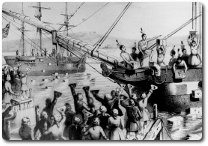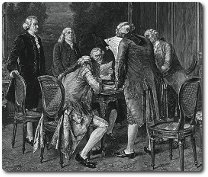Articles
- The world of the Romantics 1770 - 1837
- Romantic writers
- Key events
- Making sense of the tangible world
- Making sense of the intangible world
The American War of Independance
Colonial period
The first colonies of English settlers in North America date back to the early seventeenth century. On the whole, these colonists asserted their independence and sought to be as self-governing as possible. But British military and naval power were soon needed:
- British trade and sovereignty were threatened by other European colonies
- Conflicts with native Americans grew
- In the eighteenth century, European wars were exported to North America, especially involving the French and Spanish.
Britain wanted more control over the colonies to raise taxes to help pay the costs of military support. But this was resisted because:
- Many colonists had left Britain for religious and political freedom
- Many others were not British at all, and felt no loyalty to Britain
- The colonists had no say in voting for taxes, since these were decided by the British Parliament.
First conflicts
Opposition to Britain came to a head in the 1770s, when the number of colonies has increased to thirteen, stretching along the whole Atlantic seaboard except Florida. Trade now included slaves and had extended to other colonies in the Caribbean.
On December 16, 1773, the most rebellious colonists, in the original colony of Massachusetts, attacked a British ship in Boston Harbour carrying tea, for which the colonists were being forced to pay tax. This became popularly known as ‘The Boston Tea Party'.
After a further year of bitter arguments, the colonists attacked a British militia in April 1775, and were then attacked themselves at Bunker Hill. The same month, representatives from all the colonies met in Philadelphia to declare a state of war.
The Revolutionary War
A Virginian, George Washington, was appointed American commander. Fighting rapidly spread, with the British making New York their northern base, and Charleston, South Carolina, their southern.
The next year, the colonists met again in Philadelphia, and formally declared independence on July 4, 1776. For the first time, they saw themselves as one nation. However, a number of colonists remained loyal to the British, as did the Canadians.
Hostilities continued spasmodically between 1776-1783, though basically the war was over when, on October 19, 1781, the British commander, General Cornwallis surrendered to Washington. This occurred at Yorktown, Virginia, with the intervention of the French navy proving decisive.
The United States
 In March 1782, the British Parliament voted for peace, which was duly signed at the Treaty of Paris, September 3, 1783. The thirteen colonies were recognised as the United States of America, with territory extending westwards to the River Mississippi. Canada remained British.
In March 1782, the British Parliament voted for peace, which was duly signed at the Treaty of Paris, September 3, 1783. The thirteen colonies were recognised as the United States of America, with territory extending westwards to the River Mississippi. Canada remained British.
A constitution was drafted after lengthy negotiations between the former colonies. On April 30, 1789, George Washington became the first president.
Self determination
The Americans' refusal to accept the authority of a colonial power, made the British authorities anxious about revolutionary ferment in their own country. However, their bid for self-determination, along with the citizens of France, inspired the leaders of the Romantic movement, who saw in it an appropriate human desire to live free of oppression.
Recently Viewed
-
US war's impact
now -
The Winter's Tale » Act II, Scene i
just now -
Jane Eyre » Volume 1, Chapter 8
10 minutes ago
